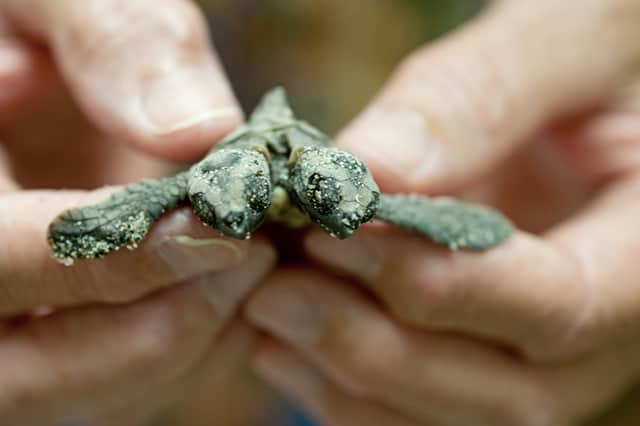Two-headed Turtle Found on Jupiter Island, Florida
OutdoorHub Reporters 08.09.12

A rare discovery of a two-headed turtle on the northern part of Jupiter Island in Florida has piqued the interest of the scientific community and Internet alike. Simon Bilts, a biologist with Ecological Associates, was excavating a sea turtle nest on the morning of July 31. He was studying the reproductive success rate of sea turtles based on hatchlings that emerged just three days earlier. He noted a few straggling hatchlings among empty egg shells, but his most stunning find was the two-headed hatchling.
Bilts was excavating the nests from 6 a.m. until after 9 a.m. In accordance with Florida Fish and Wildlife Conservation Commission guidelines, those found after 9 a.m. are put in a bucket with moist sand and covered with a towel for release after nightfall to enhance their chances for survival. Bilts was driving an ATV to the next nest when the towel blew off and he first noticed the two-headed specimen.
“Two-headed hatchlings are kind of rare,” said Erik Martin, the scientific director at Ecological Associates to KYPost.com. “I’ve only seen one before, back in 1984.”
 Niki Desjardin, a senior scientist with Ecological Associates, has also only seen isolated cases of two-headed turtles in her 11 years of studying the reptiles. There was one two-headed turtle in the 1980s and one more she saw which was only a dead embryo found in a nest.
Niki Desjardin, a senior scientist with Ecological Associates, has also only seen isolated cases of two-headed turtles in her 11 years of studying the reptiles. There was one two-headed turtle in the 1980s and one more she saw which was only a dead embryo found in a nest.
In a phone interview, Desjardin said two-headed turtles born in the wild do not have a high survival rate. Even those in captivity do not survive long. She recalls one two-headed turtle that lived for only six weeks in captivity. “Clearly, we don’t see many adult two-headed turtles,” she said.
At the Ecological Associates lab, scientists examined the turtle and determined that its shell was somewhat deformed to accommodate the two heads, but there were no further studies as to the internal organs of the turtle, according to Desjardin. It is unknown whether the turtles shared a common stomach, lung or heart. The turtle was released back into the wild after its brief examination.

